|
< Earlier Kibitzing · PAGE 2 OF 2 ·
Later Kibitzing> |
| Sep-17-07 | | vonKrolock: This game was played in August 23th 1900 in Nuremberg - therefore right after Schlechter's joint (with Pillsbury) victory in München, and probably before the gala banquet offered in Schlechter's honor by the "Schachverein" of Coburg (another city in the same region, already visited by him in other ocasions) <3...c7-c5> Introduced in the game von Bardeleben- Tarrasch, Leipzig 1888 <5...♘c6> In Monte Carlo 1903, Tarrasch with black introduced 5...e5 against Maróczy <6.g3> Prototype of the renowned "Schlechter-Rubinstein Variation" |
|
| Sep-17-07 | | King mega: taking out the trash! |
|
| Sep-17-07 | | patzerboy: Seems that 10...Ne7 was the decisive mistake. White's whole game FLOWED from that point on, almost as a forced variation. Black has choices, but most are bad. Schlechter may have played 11.Bxf6 on general principles to weaken Black's kingside, but from 12.Nf5 on he was seeing ahead several moves at a time. It's really beautiful how his offers of material dovetail together. At one point he is offering both a knight and an exchange, but Black dare not accept either. It's also beautiful how these are NOT deep combinations, but, rather, play of straightforward simplicity and great power. Reminds me of Capablanca. |
|
Sep-17-07
 | | Honza Cervenka: The order of moves in the opening is quite interesting here. 4.Nf3 is not bad but it is rather rare move as whites usually continue 4.cxd5 with idea to play against isolated Pawn or 4. e3 with idea to offer the same possibility to black with better mobility of pieces as compensation. Then Tarrasch offered the chance to create isolated Pawn on d5 once again by playing 5...Nc6 (5...Nf6 is probably the most reasonable alternative, 5...dxc4 or 5...e5 can be playable too) but Schlechter avoided this possibility once again playing 6.g3!? It seems to be that both players were quite confident that the position with isolated Pawn but mobile pieces is fine. I don't like Tarrasch's Bb4+Bxc3 idea. 7...Be7 with another offer of isolated Pawn seems to be more in the spirit of Tarrasch Defense and if black wanted to avoid this, he could have inserted 7...Bc5 8.Nb3 before playing Bb4. The difference between this and the text is that after eventual 9.0-0 black can play 9...dxc4. |
|
| Sep-17-07 | | Manequinho: Es könnte auf Deutsch sein: "Nicht schlechter als Tarrash". Or a bi-language pun: "As schlecht as it gets". |
|
| Sep-17-07 | | whiteshark: A worse day for Tarrasch |
|
| Sep-17-07 | | kevin86: Schlecter was very close to a championship one time. He needed a draw to gain the laurels,but was denied by a brilliant win by Dr. Lasker in the final game. Here he really shows his strength against a poor effort by Tarrasch,who could talk a better game then he could play. Here ST chases a passive rook while his king is left open to attack. |
|
| Sep-17-07 | | whiteshark: Schlechter won, but that doesn't mean, that every move was good. Especially <13. Nf5> was not brilliant! There were better moves. Check it out. Tarrasch, of cource, defended poorly and missed three times the better move ...exf5! here: Best possibility was after <14. Qe1> to play <14... Nxe2+! 15. Qxe2 exf5!> 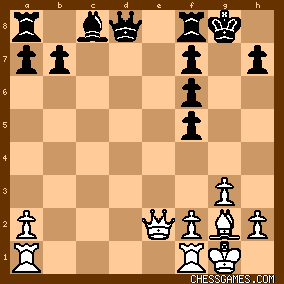
click for larger viewI guess such a move was impossible for the Doc, but thereafter black's king is safe!! He will give Pawn b7 back and play Qb6-e6... If my memory is right a tripple pawn on c- or f-file was called <Irish pawn center> in the 1980'. |
|
Sep-17-07
 | | keypusher: <kevin 86> <Here he really shows his strength against a poor effort by Tarrasch,who could talk a better game then he could play.> Bite your tongue, you impertinent whippersnapper! Dr. Tarrasch could talk a good game and play a brilliant one. He had a plus score overall against Schlechter and drew a match with him in 1911, a year after Schlechter's great showing against Lasker. http://www.chessgames.com/perl/ches... |
|
Sep-17-07
 | | fm avari viraf: Schlechter played an interesting game & capitilised on the opportunities that came his way. In the final position 25.Rh5! if ...Bxh5 26.Qxh5 Kg7 27.Qg5+ Kh8 28.Qh6  or if 25...Kg7 26.Rxh7+ Bxh7 27.Qxh7+ Kxf6 28.e5+ K moves & picking up the forlorn Queen on c2. or if 25...Kg7 26.Rxh7+ Bxh7 27.Qxh7+ Kxf6 28.e5+ K moves & picking up the forlorn Queen on c2. |
|
| Sep-17-07 | | whiteshark: <...exf5! PART II> Second possibility was after <15. Rd1> to play <15... exf5! 16. Rxd5 Qe7> 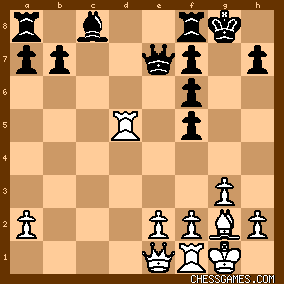
click for larger view ,
e.g. <17. Rd4 Be6 18. Qc1 Rfc8 19. Qe3 Rc7 20. Rh4 Qf8> 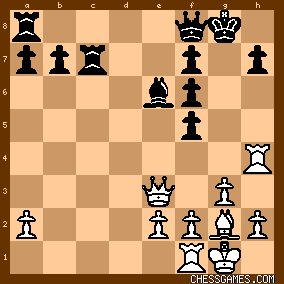
click for larger viewand black should hold the game.
|
|
| Sep-17-07 | | whiteshark: <...exf5! PART II/2> Second possibility was after <15. Rd1> to play <15... exf5! 16. <Bxd5> Qe7> 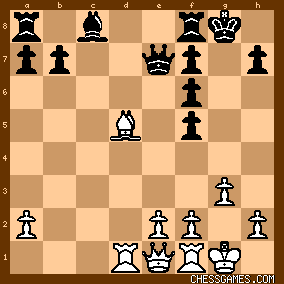
click for larger viewMaybe you are Kramnik and could find a strong continuation....
For me it's <=> after 17... Be6 |
|
| Sep-17-07 | | whiteshark: <...exf5! PART III> Third (and latest) possibility to play <...exf5!> was after <16. Bxd5> 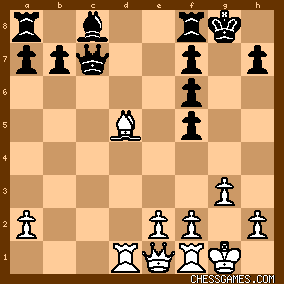
click for larger viewHow should white proceed ?
Two examples: <17. Qb4 Be6 18. Qxb7 Qxb7 19. Bxb7 Rab8> = or
<17. Qd2 Be6 18. Qh6 Rad8 19. Rc1 Qd7 20. Qxf6 Bxd5 21. Qg5+> = |
|
| Sep-17-07 | | wolfmaster: What about 25...h6? Then 26.Rxh6+ Kg7 and how does White win? |
|
Sep-17-07
 | | IMlday: IM Bryon Nickoloff always played this 4.Nf3 move order in order to avoid the drawish 11..0-0 variations of the Hennig-Shara Counter-Gambit. |
|
| Sep-24-07 | | patzerboy: Whiteshark, I think you have hit upon it: tripled pawns were psychologically impossible for Tarrasch, no matter how sound the resulting formation in the game situation. It hurts MY eyes just to look at the resulting diagram! |
|
| Oct-16-10 | | whiteshark: <patzerboy: <It hurts MY eyes just to look at the resulting diagram!>> Here you'll find some medical aid:
Game Collection: IPC = Irish Pawn Centre
(no diagrams so far :D) |
|
May-06-15
 | | keypusher: <wolfmaster: What about 25...h6? Then 26.Rxh6+ Kg7 and how does White win?> No board, but 27.Nh5+ Kxh6 (27....Bxh5 28.Qf6+) 28.Qf4+ Kxh5 29.Qh4#. Does that work? |
|
May-06-15
 | | Gypsy: <Does that work?> And if <28...Kh7>, then ...? |
|
| May-06-15 | | Tullius: After 25...h6 Black loses his Queen: 26.Rxh6+ Kg7 27.Rh7+ Bxh7 28.Qxh7+ Kxf6 29.e5+ followed by 30.Qxc2. |
|
May-07-15
 | | keypusher: <Gypsy> <Tullis> Thanks. Gypsy's move occurred to me while I was lying in bed. :) This morning I showed the position after 25....h6 to Shredder, and it initially came up with 26.Rc5, which wins the queen for nothing, but then it settled on 26.Qg5 Kg7 27.Qe5. There is a long forced mate after 27...Qb2 28.Qxb2 Rg8. Of course Tullius' combination works too, and is very pretty. |
|
May-07-15
 | | Gypsy: < Of course Tullius' combination works too, and is very pretty.> Indeed. (My 'solution' was the more mundane <25...h6 26.Rc5 Qd2 27.Rd5... 1-0> line.) |
|
Dec-11-16
 | | steinitzfan: I just had to know if this pun had been used so I did a search and sure enough this game came up. It sort of does an injustice to a great player but it's a hard one to pass up. |
|
| Dec-27-16 | | Big Pawn: Interestingly, the game Aronian vs Ivanchuk, 2016 has some surprisingly similar themes. This is a rapid game that Ivanchuk and Aronian just played and there are two aspects that are similar to this game, according to <Whiteshark's> analysis. 1. The sac on f5 to undermine d5
2. The triple pawns on the f-file.
It's interesting because I just looked at this Schlecter game last night and I saw Ivanchuk's game today. |
|
| Sep-17-17 | | Magpye: This game ended after 25...Kg7 26.Rxh7+, with the idea of 26...Bxh7 27.Qxh7 Kxf6 28.e5+, and 29.Qxd2. |
|
 |
|
< Earlier Kibitzing · PAGE 2 OF 2 ·
Later Kibitzing> |





